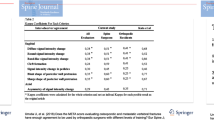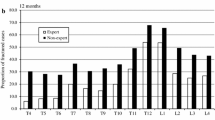Abstract
Purpose
To conduct an independent assessment of inter- and intraobserver agreement for the META score as a tool for differentiating osteoporotic vertebral fractures and multiple myeloma vertebral fractures.
Methods
This is a retrospective observational study. The magnetic resonance imaging analysis was made by two independent spinal surgeons. We designated a Subjective assessment, in which the surgeon should establish a diagnostic classification for each vertebral fracture based on personal experience: secondary to osteoporosis, categorized as a benign vertebral fracture (BVF), or attributed to multiple myeloma, categorized a malign vertebral fracture (MVF). After a 90-day interval, both surgeons repeated the evaluations. For the next step, the observers should establish a diagnosis between BVF and MVF according to the META score system, and both observers repeated the evaluations after a 90-day interval. The intra and interobserver reliability of the Subjective evaluation was studied using the kappa (κ) test. Then, the META evaluations were paralleled using the intraclass correlation coefficient (ICC).
Results
A total of 220 patients who had the potential to participate in the study were initially enrolled, but after applying the exclusion criteria, 44 patients were included. Thirty-three patients had BVF, and 12 patients presented MVF. Interobserver agreement for both Subjective evaluations moments (initial and 90-days interval) found a slight agreement for both moments (0.35 and 0.40 respectively). Kappa test for both META evaluations moments (initial and 90-days interval) found a moderate interobserver agreement for both moments (0.54 and 0.48 respectively). It was observed that the ICC calculated for the Initial evaluation using META score was 0.680 and that in the 90-days interval was 0.726, indicating regular to good agreement. Kappa test for intraobserver agreements for the Subjective evaluation presented moderate agreement for both Surgeons. On the other side, Kappa test for intraobserver agreements for the META evaluation presented substantial agreement for both Surgeons. The Intraclass Correlation Coefficient of the META score found presented an almost perfect agreement for both Surgeons.
Conclusion
Intra and interobserver agreement for both surgeons were unsatisfactory. The lack of consistent reproducibility by the same observer discourages and disfavors the routine use of the META score in clinical decision making, when potentially cases of multiple myeloma may be present.
Similar content being viewed by others
References
Melton LJ 3rd, Kan SH, Frye MA, Wahner HW, O’Fallon WM, Riggs BL (1989) Epidemiology of vertebral fractures in women. Am J Epidemiol 129(5):1000–1011
Pongchaiyakul C, Nguyen ND, Jones G, Center JR, Eisman JA, Nguyen TV (2005) Asymptomatic vertebral deformity as a major risk factor for subsequent fractures and mortality: a long-term prospective study. J Bone Miner Res 20(8):1349–1355
Longo UG, Loppini M, Denaro L, Maffulli N, Denaro V (2012) Osteoporotic vertebral fractures: current concepts of conservative care. Br Med Bull 102:171–189
Kim SR, Ha YC, Park YG, Lee SR, Koo KH (2011) Orthopedic surgeon’s awareness can improve osteoporosis treatment following hip fracture: a prospective cohort study. J Korean Med Sci 26(11):1501–1507
Melton LJ 3rd, Chrischilles EA, Cooper C, Lane AW, Riggs BL (1992) Perspective How many women have osteoporosis? J Bone Miner Res 7(9):1005–1010
Johnell O, Kanis JA (2006) An estimate of the worldwide prevalence and disability associated with osteoporotic fractures. Osteoporos Int 17(12):1726–1733
Lems WF (2007) Clinical relevance of vertebral fractures. Ann Rheum Dis 66(1):2–4
Lindsay R, Silverman SL, Cooper C et al (2001) Risk of new vertebral fracture in the year following a fracture. JAMA 285(3):320–323
Cowan AJ, Allen C, Barac A et al (2018) Global burden of multiple myeloma: a systematic analysis for the global burden of disease study 2016. JAMA Oncol 4(9):1221–1227
Lecouvet FE, Vande Berg BC, Maldague BE et al (1997) Vertebral compression fractures in multiple myeloma Part I distribution and appearance at MR imaging. Radiology 204(1):195–199
Spratt DE, Beeler WH, de Moraes FY et al (2017) An integrated multidisciplinary algorithm for the management of spinal metastases: an International spine oncology consortium report. Lancet Oncol 18(12):e720–e730
Kato S, Hozumi T, Yamakawa K, Saito M, Goto T, Kondo T (2015) META: an MRI-based scoring system differentiating metastatic from osteoporotic vertebral fractures. Spine J 15:1563–1570. https://doi.org/10.1016/j.spinee.2015.03.011
Takigawa T, Tanaka M, Sugimoto Y, Tetsunaga T, Nishida K, Ozaki T (2017) Discrimination between malignant and benign vertebral fractures using magnetic resonance imaging. Asian Spine J 11:478–483. https://doi.org/10.4184/asj.2017.11.3.478
Baur A, Huber A, Ertl-Wagner B, Durr R, Zysk S, Arbogast S, Deimling M, Reiser M (2001) Diagnostic value of increased diffusion weighting of a steady-state free precession sequence for differentiating acute benign osteoporotic fractures from pathologic vertebral compression fractures. AJNR Am J Neuroradiol 22:366–372
Chiari-Correia NS, Nogueira-Barbosa MH, Chiari-Correia RD, Azevedo-Marques PM (2023) A 3D Radiomics-based artificial neural network model for benign versus malignant vertebral compression fracture classification in MRI. J Digit Imaging 36(4):1565–1577. https://doi.org/10.1007/s10278-023-00847-4
Wáng YXJ, Santiago FR, Deng M, Nogueira-Barbosa MH (2017) Identifying osteoporotic vertebral endplate and cortex fractures. Quant Imaging Med Surg 7(5):555–591. https://doi.org/10.21037/qims.2017.10.05
Frighetto-Pereira L, Rangayyan RM, Metzner GA, de Azevedo-Marques PM, Nogueira-Barbosa MH (2016) Shape, texture and statistical features for classification of benign and malignant vertebral compression fractures in magnetic resonance images. Comput Biol Med 1(73):147–156. https://doi.org/10.1016/j.compbiomed.2016.04.006
Lems WF (2007) Clinical relevance of vertebral fractures. Annals of the rheumatic diseases 66(1):2–4
Lindsay R, Silverman SL, Cooper C, Hanley DA, Barton I, Broy SB, Licata A, Benhamou L, Geusens P, Flowers K, Stracke H, Seeman E (2001) Risk of new vertebral fracture in the year following a fracture. JAMA 285:320–323
Nevitt MC, Ettinger B, Black DM, Stone K, Jamal SA, Ensrud K, Segal M, Genant HK, Cummings SR (1998) The association of radiographically detected vertebral fractures with back pain and function: a prospective study. Ann Intern Med 128:793–800
Urrutia J, Besa P, Morales S et al (2018) Does the META score evaluating osteoporotic and metastatic vertebral fractures have enough agreement to be used by orthopaedic surgeons with different levels of training? Eur Spine J 27(10):2577–2583. https://doi.org/10.1007/s00586-018-5694-x
Dos Santos IMG, Herrero CFPDS, Pratali RDR, Agnollitto PM, Waib FF, Nogueira-Barbosa MH (2023) Agreement on mri diagnosis in compressive malignant vertebral fractures. Acta Ortop Bras 31:e258926
Rajkumar SV, Dimopoulos MA, Palumbo A et al (2014) International myeloma working group updated criteria for the diagnosis of multiple myeloma. Lancet Oncol 15:e538–e548
Besa P, Urrutia J, Campos M et al (2018) The META score for differentiating metastatic from osteoporotic vertebral fractures: an independent agreement assessment. The Spine J 18(11):2074–2080. https://doi.org/10.1016/j.spinee.2018.04.024
Funding
This study did not receive any funding sources whether private, public or non-profit sectors.
Author information
Authors and Affiliations
Contributions
Each author fulfills the requirements: Substantial contributions to the conception or design of the work; Acquisition, analysis, or interpretation of data; Drafting the work or revising it critically for important intellectual content; Final approval of the version to be published; Agreement to be accountable for all aspects of the work in ensuring that questions related to the accuracy or integrity of any part of the work are appropriately investigated and resolved:Eduardo Henrique Chiovato Abdala: Acquisition, analysis, or interpretation of data; Drafting the work and revising it critically for important intellectual content. João Pedro Almeida e Oliveira: Acquisition, analysis, and interpretation of data; Drafting the work.Mariana Demétrio de Sousa Pontes: Acquisition of data; Drafting the work; Revising it critically for important intellectual content. Ângelo Augusto Bongiolo Ganeo: Conception or design of the work; Revising it critically for important intellectual content. Marcelo Henrique Nogueira-Barbosa: Conception or design of the work; Revising it critically for important intellectual content. Carlos Fernando P. S. Herrero: Conception or design of the work; Revising it critically for important intellectual content.
Corresponding author
Ethics declarations
Conflict of interest
The authors declare that there is no conflict of interest.
Additional information
Publisher's Note
Springer Nature remains neutral with regard to jurisdictional claims in published maps and institutional affiliations.
Rights and permissions
Springer Nature or its licensor (e.g. a society or other partner) holds exclusive rights to this article under a publishing agreement with the author(s) or other rightsholder(s); author self-archiving of the accepted manuscript version of this article is solely governed by the terms of such publishing agreement and applicable law.
About this article
Cite this article
Abdala, E.H.C., Oliveira, J.P.A.e., de Sousa Pontes, M.D. et al. Assessment of inter- and intraobserver agreement for META score in distinguishing osteoporotic from multiple myeloma vertebral fractures. Eur Spine J (2024). https://doi.org/10.1007/s00586-024-08287-6
Received:
Revised:
Accepted:
Published:
DOI: https://doi.org/10.1007/s00586-024-08287-6




